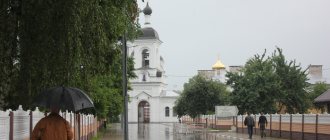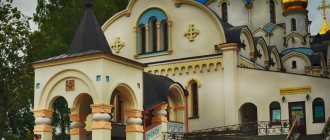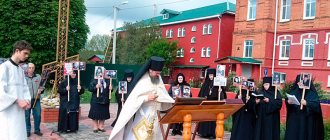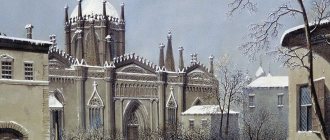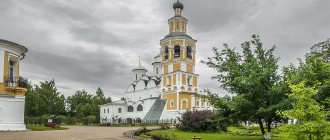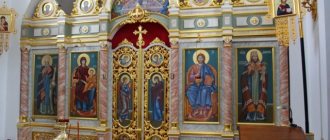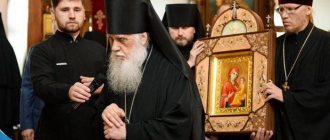Schedule of services for June 2021 |
Information about the time and procedure for performing the sacrament of confession in our church
Behind the candle box of the temple you can order various prayer services - simple and water-blessing services, memorial services. Also in the temple the Psalter is read in memory of the living and the dead.
| date | Day | Time | Divine service | Saints celebrated |
| 1 | Tue | 8-00 | Matins. Liturgy | Blgvv. led book Dimitri Donskoy and led. book Evdokia |
| 17-00 | All-night vigil | Celebrating the Feast of Mid-Pentecost. St. Alexy, Metropolitan of Moscow and All Russia Wonderworker | ||
| 2 | Wed | 9-00 | Liturgy | |
| 17-00 | All-night vigil | Vladimir Icon of the Mother of God. Equal App. Konstantin and Elena | ||
| 3 | Thu | 9-00 | Liturgy | |
| 17-00 | Vespers. Prayer service with akathist to St. Nicholas | Right Jacob Borovichsky, Novgorodsky | ||
| 4 | Fri | 8-00 | Matins. Liturgy | |
| 17-00 | Vespers. Prayer service to all the saints who have shone in the Russian land | St. Leontia, bishop Rostovsky. St. Euphrosyne of Polotsk | ||
| 5 | Sat | 8-00 | Matins. Liturgy | |
| 17-00 | All-night vigil | 6th week of Easter, about the blind man. Blzh. Ksenia of Petersburg | ||
| 6 | Sun | 7-00 | Early Liturgy | |
| 9-30 | Late Liturgy | |||
| 17-00 | All-night vigil | The Third Finding of the Head of the Forerunner and Baptist of the Lord John | ||
| 7 | Mon | 9-00 | Liturgy | |
| 17-00 | Vespers. Prayer service with akathist sschmch. Sergius | St. Macarius Kalyazinsky | ||
| 8 | Tue | 8-00 | Matins. Liturgy | |
| 17-00 | Vespers. Easter Matins | Celebration of Easter holiday | ||
| 9 | Wed | 9-00 | Liturgy | |
| 17-00 | All-night vigil | Ascension of the Lord | ||
| 10 | Thu | 7-00 | Early Liturgy | |
| 9-30 | Late Liturgy | |||
| 17-00 | Vespers. Matins with polyeleos | After-feast of the Ascension of the Lord. St. Luke isp., archbishop. Simferopolsky. Icon of the Mother of God “Helper of Sinners” | ||
| 11 | Fri | 9-00 | Liturgy | |
| 17-00 | Vespers. Prayer service to all the saints who have shone in the Russian land | St. Isaac of Spain, abbot of the Dalmatian monastery | ||
| 12 | Sat | 8-00 | Matins. Liturgy | |
| 17-00 | All-night vigil | 7th Sunday of Easter, Holy Fathers of the First Ecumenical Council | ||
| 13 | Sun | 7-00 | Early Liturgy | |
| 9-30 | Late Liturgy | |||
| 17-00 | All-night vigil | Right John of Kronstadt | ||
| 14 | Mon | 9-00 | Liturgy | |
| 17-00 | Vespers. Prayer service with akathist sschmch. Sergius | Right Juliania of Novotorzhskaya | ||
| 15 | Tue | 8-00 | Matins. Liturgy | |
| 17-00 | Vespers. Prayer service with akathist to St. right Alexy | Blgv. Tsarevich Dimitry of Uglich | ||
| 16 | Wed | 8-00 | Matins. Liturgy. | |
| 17-00 | Vespers. Prayer service before the Feodorovskaya Icon of the Mother of God | St. Methodius of Peshnoshsky | ||
| 17 | Thu | 8-00 | Matins. Liturgy | |
| 17-00 | Vespers. Matins | Celebration of the Feast of the Ascension of the Lord | ||
| 18 | Fri | 9-00 | Liturgy | |
| 17-00 | Funeral Vespers and Matins (parastas) | Trinity Parents' Saturday | ||
| 19 | Sat | 9-00 | Liturgy. Memorial service | |
| 17-00 | All-night vigil | Day of the Holy Trinity. Pentecost | ||
| 20 | Sun | 7-00 | Early Liturgy | |
| 9-30 | Late Liturgy. Vespers | |||
| 17-00 | Matins | Holy Spirit Day | ||
| 21 | Mon | 9-00 | Liturgy | |
| 15-00 | Small Vespers with Akathist to St. right Alexy | Right Alexy, presbyter of Moscow. Patronal holiday | ||
| 17-00 | All-night vigil | |||
| 22 | Tue | 7-00 | Early Liturgy | |
| 9-30 | Late Liturgy. Procession | |||
| 17-00 | Vespers. Prayer service with akathist to St. right Alexy | St. Vasily Ryazansky | ||
| 23 | Wed | 8-00 | Matins. Liturgy | |
| 17-00 | Vespers. Matins with polyeleos | Apostles Bartholomew and Barnabas. Icon of the Mother of God, called “It is Worthy to Eat” | ||
| 24 | Thu | 9-00 | Liturgy | |
| 17-00 | Vespers. Prayer service with akathist to St. Nicholas | Blgv. led book Anna Kashinskaya | ||
| 25 | Fri | 8-00 | Matins. Liturgy | |
| 17-00 | Vespers. Matins | Celebration of the Feast of Pentecost | ||
| 26 | Sat | 9-00 | Liturgy | |
| 17-00 | All-night vigil | 1st Sunday after Pentecost. All Saints | ||
| 27 | Sun | 8-00 | Confession. Watch | |
| 9-00 | Liturgy | |||
| 17-00 | All-night vigil | St. Jonah, Met. Wonderworker of Moscow and all Russia. Beginning of Peter's Lent | ||
| 28 | Mon | 9-00 | Liturgy | |
| 17-00 | Vespers. Prayer service with akathist sschmch. Sergius | St. Tikhon Medynsky. St. Feofan the Recluse Vyshensky | ||
| 29 | Tue | 8-00 | Matins. Liturgy | |
| 17-00 | Vespers. Prayer service with akathist to St. right Alexy | Mchch. Manuel, Savel and Ismail | ||
| 30 | Wed | 8-00 | Matins. Liturgy | |
| 17-00 | All-night vigil |
In the schedule of services of the Church of St. , the twelfth holidays, Sundays and patronal feasts of the temple are highlighted in red, and the days of celebration of especially revered saints and other memorable dates are highlighted
in green
Polotsk St. Euphrosyne Monastery - tree
Article from the encyclopedia “Tree”: drevo-info.ru
| Polotsk Spaso-Euphrosinievsky Monastery. Photo September 27, 2009, during the patriarchal visit. |
Euphrosyne Convent in the name of the All-Merciful Savior in Polotsk
Polotsk diocese
Initially, on the site of the current monastery there was a bishop's estate with a temple-tomb for the Polotsk bishops and a wooden Spassky Church.
In 1125, the Venerable Euphrosyne of Polotsk moved here and around 1128 a monastic monastery was born here thanks to her ascetic life.
In the middle of the 12th century, on the site of the saint’s wooden church, a stone temple was erected in the name of the All-Merciful Savior, which has survived to this day.
Also, by order of the saint in 1161, the Exalted Cross was made - a cross-ark with many shrines: particles of the Tree of the Holy Cross, stones of the Holy Sepulcher and the Sepulcher of the Mother of God, the relics of the first martyr Archdeacon Stephen and the great martyr and healer Panteleimon.
The Orthodox monastery continued to exist until 1580, when Polotsk became part of the Polish-Lithuanian Commonwealth and the monastery was transferred to the Roman Catholics. It was occupied by Jesuit monks.
In 1656, when the troops of the Russian Tsar Alexei Mikhailovich entered Polotsk, the monastery was returned to the Orthodox, but already in 1667, according to the Treaty of Andrusov, Polotchina was returned to the Polish-Lithuanian Commonwealth, and the Spassky Church again went to the Jesuits.
Only through the efforts of the Bishop of Mogilev and Vitebsk, Saint Gabriel, in 1832 was the Savior Church again transferred to the Orthodox.
Polotsk Bishop Vasily (Luzhinsky), who ascended the see in 1840, saw one of his main tasks as the restoration of ancient Polotsk shrines, which is why he managed to collect donations for 30,000 rubles in banknotes, and achieve the publication in October 1841 of the Highest Decree on the revival of the Polotsk Convent.
Six months later, on the day of remembrance of the saint, May 23, 1842, the memorable Cross of St. Euphrosyne was transferred from the St. Sophia Cathedral to the Transfiguration Church for eternal storage.
».
With funds donated in Moscow and St. Petersburg, until 1848, it was possible to repair or re-build buildings for all monastic services, to erect a house to house a women's religious school, which became the successor to the school founded by Saint Euphrosyne at the monastery.
On May 23, 1893, in the Spaso-Euphrosinievsky Monastery, Bishop Antonin of Pskov and Porkhov laid the first stone in the foundation of the new Exaltation of the Cross Cathedral. The majestic five-domed cathedral, designed for 1,500 people, was built according to the design of the architect V. F. Korshikov.
The cathedral church was completed by 1897. In those years, Abbess Evgenia (Govorovich) labored in the monastery, thanks to whose activities the number of nuns (including novices) reached 117 people by the end of the 19th century.
The Holy Euphrosyne Monastery became a major center of spiritual and social service of the Orthodox Church.
In 1910, the holy relics of St. Euphrosyne were transferred from Kiev to Polotsk, but during the First World War, in 1915, when Polotsk found itself in the position of a front-line city, the incorruptible relics were evacuated to Rostov the Great and placed in the Epiphany Abrahamic Monastery, where they were located for five years.
After the revolution of 1917, despite persecution, the Holy Euphrosyne Monastery continued to operate until 1928.
During the Second World War, during the German occupation, Orthodox believers transferred the incorrupt relics of St. Euphrosyne from the local anti-religious museum to the Vitebsk Intercession Church, where they remained until 1943, and then to the Spassky Monastery. The monastery reopened, despite the fact that part of the monastery was converted by the Germans into a concentration camp.
After the end of the war, the monastery continued to operate. The number of nuns has increased. Already in 1952 there were 52 of them. However, starting from 1955, it was forbidden to register new nuns and novices in the monastery, and in 1960 the Savior Euphrosyne Monastery was closed. For thirty years the monastery was desolate.
On July 6, 1989, the Holy Synod of the Russian Orthodox Church blessed the revival of the Savior Euphrosyne Convent.
In September 1997, on the eve of the Feast of the Exaltation of the Holy Cross, the Exaltation of the Cross of St. Euphrosyne was solemnly brought to the monastery. The significance of the monastery as an ancient stronghold of Orthodoxy in Belarus is increasing again.
All-Russian Patriarchs visited here during the celebration of the Exaltation of the Cross - Alexy II on September 26-27, 1998 and Kirill on September 27, 2009.
The monastery lives according to the community rules. As of 2009, about 70 sisters labored in the monastery. Regular services are held daily in the morning and evening, and the incessant Psalter is read. The monastery hospitably welcomes all pious pilgrims. The previously rich monastery library has been lost, and a new one is currently being created.
Shrines
The main shrine of the monastery is the relics of St. Euphrosyne of Polotsk, located in the Cathedral of the Exaltation of the Cross. The ancient Transfiguration Church houses the Euphrosyne Cross, a copy of the ancient Euphrosyne Cross.
| Euphrosyne Church of the Polotsk Spaso-Euphrosyne Monastery. Photo August 2006 |
Temples
- Cathedral of the Exaltation of the Cross (1897).
- Transfiguration Church (XII) – contains unique frescoes of the 12th century, as well as oil paintings of the 19th century. In 2009, work was underway to restore the temple in accordance with the decision of the government of Belarus. The restoration of the painting is being carried out by a group of the interregional scientific and restoration art department under the Ministry of Culture and Mass Communications of Russia, headed by V. D. Sarabyanov, and Belarusian specialists from the “Ministry of Restoration”.
- Euphrosyne Church (1847).
Used materials
[1] Sister of St.
Euphrosyne, Princess of Polotsk. [2] Princess of Polotsk. [3] In historical sources there are different spellings of the surname of Abbess Innokentia - Kuleshova, Kulesha, Kuleshchanina, Kuleshanka. [4] In historical sources there are different spellings of the surname of Abbess Euphrosyne - Degtyarev, Dekhterev, Dekhtyarev. [5] Decision of the Synod of the Belarusian Orthodox Church (magazine No. 65): //church.by/sinod/zhurnaly-zasedanija-sinoda-belorussko…oda Source: //drevo-info.ru/articles/13759.html
Spaso-Euphrosinievsky Women's Monastery of Polotsk: history, description
In the 12th century, which marked the heyday of monasticism on the ancient land of Polotsk, the future saint, Venerable Euphrosyne, shone in it. The monastery she created, having gone through long centuries of difficult and sometimes dramatic history, has survived to this day, becoming a monument to this saint of God, who now prays for all of us before the Throne of the Most High.
God-loving princess
The Monk Euphrosyne, who founded the Polotsk monastery, came from an ancient princely family that originated from the baptist of Rus', Equal-to-the-Apostles Prince Vladimir and his pious wife Rogneda.
In holy baptism she was named Predslava.
Having learned to read and write at an early age, the young princess, avoiding the games and amusements typical of all children, spent time reading the Holy Scriptures and conversations with her spiritual mentor - the rector of the parish church, who often visited her father's house.
Such zeal aroused the respect of loved ones, but no one could foresee that young Predslava would choose for herself the difficult and thorny path of monasticism, giving it preference over all the temptations of worldly life. And that’s exactly what happened.
Beginning of monastic service
When the girl turned twelve years old, which at that time was considered adulthood, many very enviable grooms began to woo her as an eminent, rich and beautiful bride.
But they all received a decisive refusal.
In response to her father’s threat to force her into marriage, the girl secretly fled from home and took monastic vows in one of the nearby monasteries, receiving a new name - Euphrosyne.
The life of the saint tells us that she spent the beginning of her monastic journey in labor, copying ancient tomes kept in the library of the Polotsk St. Sophia Cathedral. Printing had not yet been invented, and the Holy Scriptures, patericons and other spiritual literature had to be reproduced only in this way.
Order of the Messenger of God
But soon the Lord called her to a different path. A heavenly angel was sent to Euphrosyne, who showed her the place where the Polotsk monastery would subsequently be founded. From that time on, the saint settled near the Church of the Savior in a place called Selts, two miles from the city. Along with her, another blueberry came there, whose name history has not preserved. This happened in 1125.
Filled with humility, the nun Euphrosyne wanted to serve God in solitude, secluded from the whole world, but the Lord did not want such a bright lamp of faith to remain hidden. Very soon, other maidens, fascinated by Christ, began to gather and settle around her.
Construction of the temple and creation of a new monastery
Over time, the community created in this way, from which the Polotsk Monastery was subsequently formed, became quite numerous. In this regard, the reverend abbess wished to erect a new stone church on the site of the wooden church, which by that time had become dilapidated.
Local residents contributed to such a charitable cause. Voluntary donors were also found in Polotsk itself. Through their efforts, the necessary funds were collected.
A local architect named John took charge of all the work.
Through the prayers of Mother Superior Euphrosyne, the Lord sent down His grace on the builders of the new temple, and within seven months the walls, crowned with domes, rose to the sky, and the best craftsmen painted them with marvelous frescoes.
Over time, the Polotsk convent grew, became stronger and, after the name of the temple erected in it, began to be called the Spasskaya Convent.
In 1155, the venerable abbess founded another monastery nearby, this time for men, first building the Church of the Blessed Virgin Mary. These two monasteries became true centers of enlightenment in the Polotsk region.
They opened schools, libraries and scriptoriums - workshops for copying handwritten books.
Death in the Holy Land
In 1173, foreseeing her imminent death, the Monk Euphrosyne wished to pay her last debt to the Lord - to make a pilgrimage to the Holy Land and venerate the places associated with his earthly life.
Together with her sister Eupraxia and brother David, she left Polotsk in January and, after four months of grueling walking, reached Jerusalem, where she was honored to bow to the Holy Sepulcher.
And then the Venerable Euphrosyne was nearly seventy years old.
The difficult journey to the Holy Land was not in vain for the old woman. Soon she fell ill, lay down, and on May 23 she gave up her soul to the Lord, whom she served all her life.
Abbess Euphrosyne, who founded the Polotsk monastery in her homeland, in Jerusalem, in the monastery of St. Theodosius the Great, was buried.
Fourteen years later, her incorruptible relics were transported and placed in the Kiev Pechersk Lavra as the greatest shrine.
Subsequent life of the monastery
After the repose of the holy abbess, the monasteries founded by her continued to develop and prosper, but ahead of them lay the difficult trials that befell the Russian land in the 16th and 18th centuries. The men's monastery was destroyed and has not survived to this day, but the Polotsk Spaso-Euphrosinievsky Monastery, having survived years of decline and poverty, managed to be revived in the 19th century.
In 1833, work began on a major overhaul of the Spassky Church, which had become very dilapidated by that time and had been neglected in recent years. Other monastery buildings were also repaired, and a little to the side, on the banks of the Polota River, a new sister cell building was erected.
In the second half of the 19th century, two more churches appeared on the territory of the monastery - in honor of St. Euphrosyne of Polotsk and the Cathedral of the Exaltation of the Cross. At the same time, the monastery of Euphrosyne of Polotsk was ranked among the first-class monasteries, and a women’s theological school began operating under it, which reached its heyday at the beginning of the 20th century.
Shortly before the October Revolution, the relics of the founder of the monastery were solemnly transferred from the caves of the Kiev Pechersk Lavra to Polotsk. So, after seven hundred years, Saint Euphrosyne returned to her brainchild. The Polotsk monastery greeted her with the solemn ringing of the bells of all its churches.
